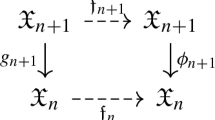Abstract
We show a connection between the \(CDE'\) inequality introduced in Horn et al. (Volume doubling, Poincaré inequality and Gaussian heat kernel estimate for nonnegative curvature graphs. arXiv:1411.5087v2, 2014) and the \(CD\psi \) inequality established in Münch (Li–Yau inequality on finite graphs via non-linear curvature dimension conditions. arXiv:1412.3340v1, 2014). In particular, we introduce a \(CD_\psi ^\varphi \) inequality as a slight generalization of \(CD\psi \) which turns out to be equivalent to \(CDE'\) with appropriate choices of \(\varphi \) and \(\psi \). We use this to prove that the \(CDE'\) inequality implies the classical CD inequality on graphs, and that the \(CDE'\) inequality with curvature bound zero holds on Ricci-flat graphs.
Similar content being viewed by others
References
Bakry, D., Émery, M.: Diffusions hypercontractives. (French) [Hypercontractive diffusions]. Séminaire de probabilité, XIX, 1983/84, pp. 177–206. Lecture Notes in Mathematics, vol. 1123. Springer, Berlin (1985)
Bauer, F., Horn, P., Lin, Y., Lippner, G., Mangoubi, D., Yau, S.-T.: Li–Yau inequality on graphs. J. Differ. Geom. 3, 359–405 (2015)
Chung, F., Yau, S.-T.: Logarithmic Harnack inequalities. Math. Res. Lett. 3, 793–812 (1996)
Horn, P., Lin, Y., Liu, S., Yau, S.-T.: Volume doubling, Poincaré inequality and Gaussian heat kernel estimate for nonnegative curvature graphs (2014). arXiv:1411.5087v2
Münch, F.: Li–Yau inequality on finite graphs via non-linear curvature dimension conditions (2014). arXiv:1412.3340v1
Acknowledgements
I wish to thank Matthias Keller and Daniel Lenz for their support and for sharing ideas in many fruitful discussions.
Author information
Authors and Affiliations
Corresponding author
Additional information
Communicated by J. Jost.
Appendix A
Appendix A
Definition A.1
(Graph) A pair \(G=(V,E)\) with a finite set V and a relation \(E \subset V\times V\) is called a finite graph if \((v,v) \notin E\) for all \(v \in V\) and if \((v,w) \in E\) implies \((w,v) \in E\) for \(v,w \in V\). For \(v,w \in V\), we write \(v \sim w\) if \((v,w) \in E\).
Definition A.2
(Laplacian \(\Delta \)) Let \(G=(V,E)\) be a finite graph. The Laplacian \(\Delta : C(V) := {\mathbb {R}}^V \rightarrow C(V)\) is defined for \(f \in C(V)\) and \(v \in V\) as \( \Delta f (v) := \sum _{w \sim v} (f(w) - f(v)). \)
Definition A.3
We write \(\mathbb {R}^{+}:= (0,\infty )\) and \(\mathbb {R}^{+}_{0}:= [0,\infty )\). Let \(G=(V,E)\) be a finite graph. Then, we write \( C^+(V) := \{f:V \rightarrow \mathbb {R}^{+}\}. \)
Definition A.4
(Heat operator \(\mathcal L\)) Let \(G=(V,E)\) be a graph. The heat operator \(\mathcal L: C^1(V \times \mathbb {R}^{+}) \rightarrow C(V \times \mathbb {R}^{+})\) is defined by \(\mathcal L(u) := \Delta u - \partial _t u\) for all \(u \in C^1(V \times \mathbb {R}^{+})\). We call a function \(u \in C^{1}( V \times \mathbb {R}^{+}_{0})\) a solution to the heat equation on G if \(\mathcal L(u) = 0\).
Definition A.5
(Ricci-flat graphs) Let \(D \in {\mathbb {N}}\). A finite graph \(G = (V,E)\) is called D-Ricci-flat in \(v \in V\) if all \(w \in N(v):=\{v\} \cup \{w \in V: w \sim v\}\) have the degree D, and if there are maps \(\eta _1,\ldots ,\eta _D : N(v) \rightarrow V \), such that for all \(w \in N(v)\) and all \(i, j \in \{1,\ldots ,D\}\) with \(i \ne j\), one has \(\eta _i(w) \sim w\), \(\eta _i(w) \ne \eta _j(w)\), \(\bigcup _k \eta _k(\eta _i(v)) = \bigcup _k \eta _i(\eta _k(v))\). The graph G is called D-Ricci-flat if it is D-Ricci-flat in all \(v \in V\).
1.1 A.1 The CD condition via \(\Gamma \) calculus
We give the definition of the \(\Gamma \)-calculus and the CD condition following [1].
Definition A.6
(\(\Gamma \)-calculus) Let \(G=(V,E)\) be a finite graph. Then, the gradient form or carré du champ operator \(\Gamma : C(V) \times C(V) \rightarrow C(V)\) is defined by
Similarly, the second gradient form \(\Gamma _2 : C(V) \times C(V) \rightarrow C(V)\) is defined by
We write \(\Gamma (f):= \Gamma (f,f)\) and \(\Gamma _2 (f):= \Gamma _2 (f,f)\).
Definition A.7
(CD inequality) Let \(G=(V,E)\) be a finite graph and \(d \in \mathbb {R}^{+}\). We say G satisfies the curvature-dimension inequality CD(d, K) if for all \(f \in C(V)\),
We can interpret this as meaning that the graph G has a dimension (at most) d and a Ricci curvature larger than K.
1.2 A.2 The CDE and \(CDE'\) conditions via \(\widetilde{\Gamma _2}\)
We give the definitions of CDE and \(CDE'\) following [2, 4]
Definition A.8
(The CDE inequality) We say that a graph \(G=(V,E)\) satisfies the CDE(x, d, K) inequality if for any \(f \in C^+(V)\) such that \(\Delta f (x) <0\), we have
We say that CDE(d, k) is satisfied if CDE(x, d, K) is satisfied for all \(x \in V\).
Definition A.9
(The \(CDE'\) inequality) We say that a graph \(G=(V,E)\) satisfies the \(CDE'(d,K)\) inequality if for any \(f \in C^+(V)\), we have
1.3 A.3 The \(CD\psi \) conditions via \(\Gamma ^\psi \) calculus
We give the definition of the \(\Gamma ^\psi \)-calculus and the \(CD\psi \) condition following [5].
Definition A.10
(\(\psi \)-Laplacian \(\Delta ^\psi \)) Let \(\psi \in C^1(\mathbb {R}^{+})\) and let \(G=(V,E)\) be a finite graph. Then, we call \(\Delta ^\psi : C^+(V) \rightarrow C(V)\), defined as
the \(\psi \) -Laplacian.
Definition A.11
(\(\psi \)-gradient \(\Gamma ^\psi \)) Let \(\psi \in C^1(\mathbb {R}^{+})\) be a concave function and let \(G=(V,E)\) be a finite graph. We define
Moreover, we define the \(\psi \)-gradient as \(\Gamma ^\psi : C^+(V) \rightarrow C(V)\),
Definition A.12
(Second \(\psi \)-gradient \(\Gamma _2^\psi \)) Let \(\psi \in C^1(\mathbb {R}^{+})\), and let \(G=(V,E)\) be a finite graph. Then, we define \(\Omega ^\psi : C^+(V) \rightarrow C(V)\) by
Furthermore, we define the second \(\psi \)-gradient \(\Gamma _2^\psi : C^+(V) \rightarrow C(V)\) by
Definition A.13
(\(CD\psi \) condition) Let \(G=(V,E)\) be a finite graph, \(K \in {\mathbb {R}}\) and \(d \in \mathbb {R}^{+}\). We say G satisfies the \(CD\psi (d,K)\) inequality if for all \(f \in C^+(V)\), one has




